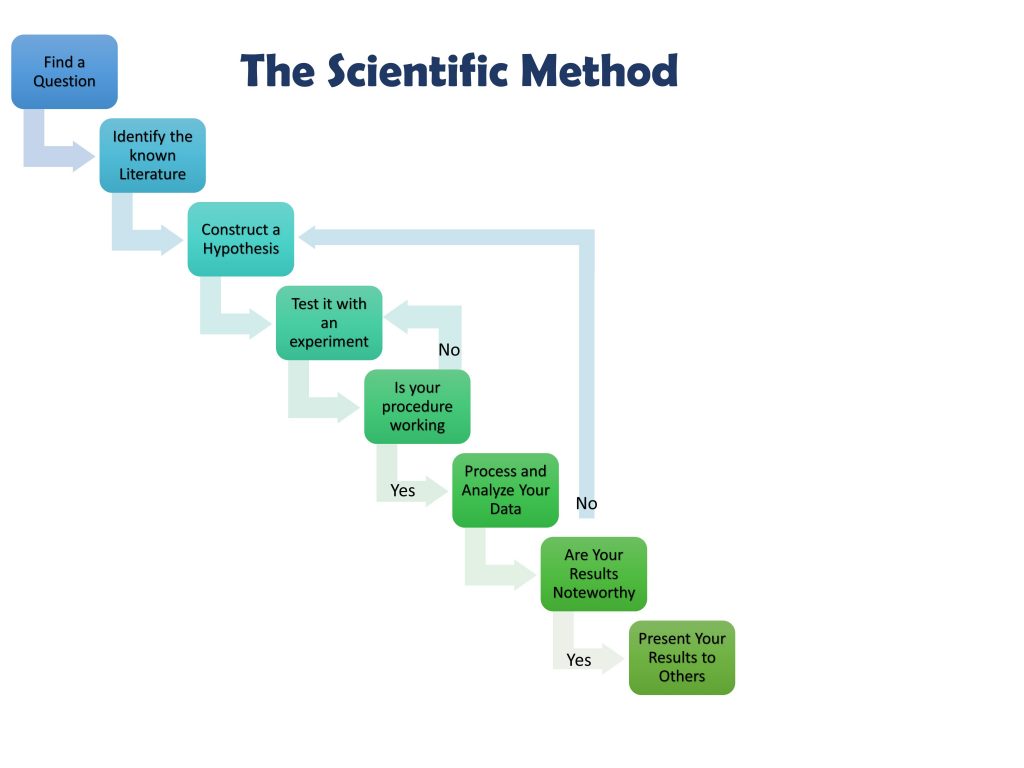Many students believe that the at home research project could never compete with a research project that was performed at a university. However, that is not true. This is the product of a built in misconception that science competitions are looking for the “best science,” but that is simply not true. They are looking for the best designed experiments, with quality data analysis, and excellent communication skills. In most cases the scientists judging the projects are deeply disappointed in projects when they see design flaws in the way data was collected, huge amounts of error, or simply not enough data collected to prove the thesis. While working with a university professor will likely bring these things to your students’ project with less work on your end and possibly even theirs, it is possible to bring your student projects to this level if they are willing to put in the extra time to strengthen these areas of the project.
So what should you teach to get them started?
Start with the Scientific Method
Illustrate to the students that there are many steps along the way to a successful poster or research paper. And don’t forget to remind them that some steps may need to be revisited!
There are some great places to find content on the scientific method, but here is a video that you can show your students:
Of course we also advise you to use Monty Python to teach by example!
Otherwise use a catchy song!
Now to Start Focusing on Those Skills
Searching the Literature
We advise that you begin to bring your librarian in or take your students to the library to help with this part. There is no reason to “reinvent the wheel” here. Your librarians are already trained in these skills and should already be able to thoroughly teach this skill. Of course, you could teach search the literature with the literature…
 Loading...
Loading...
Designing a Hypothesis
All scientists work to answer questions in a similar way and teaching how to form a hypothesis is still the best way to convey the ideas. There is a lot of good content on this topic and if your students work best by song and dance then we recommend starting here otherwise there is a great visual in the video below:
Testing with an Experiment
This is where you will need to talk a bit about how to set up an experiment. All science competitions for middle school and high school level projects will be looking for some discussion of controls, variables (independent and dependent), replicates, variability (precision and accuracy), etc.
Some Longwood faculty have created helpful resources:
 Loading...
Loading...
While there are great videos out there also. Here is one from a popular study resource site called Kahn Academy:
Of course as your students get into the “nitty gritty” of designing their experiments this is were they may need customized advice and you are welcome to use some of our Longwood contacts to help with some of the more difficult experiments to design.
Analyzing your Data
There are some broader data analyses that judges and certain competitions look for and focusing some class time on these things can be great for your students. Depending on what your students get into there might be more field specific analyses that come up and asking someone in the field might be best. Some of the these broader analyses include:
Significant figures: Honestly, inaccuracies here only show that the students don’t understand the limits of their accuracies when it comes to their own experimental methods. Admittedly, it may feel like something more is being read into their possible ignorance on the issue, but either way it looks really bad when data has WAY to much accuracy (ex. percent growth = 27.09567489%).
Replicates: In general three replicates tends to be enough, but again the more difficult part is teaching the students how the choice of what to replicate limits your analysis. For a great Layman’s resource on the topic check out this video from StatQuest. Judges that are scientists will immediately pick up on cases where students claim that variations in their sample mean more about a subject than they actually do. So make sure your students aren’t claiming that their data amounts to more than it actually does.
Standard deviations: Students need to be able to show some variability in the data. In many cases the competition guidelines or “judges sheets” will list what is required, but it is best to assume that you will need to teach the students how to find the standard deviation in their data.
Error bars: Honestly sometimes just having them will help, but if the judges start asking questions about how reliable is the data based on the error bars then the student needs to be ready to talk about it. You can find a bunch of great sources on error bars, but maybe this cell bio article on the topic can help? For the most part, the students need to know both how error bars indicate how trustworthy the data is and how reliable their comparison between two measurements are if the error bars overlap.
T-test analysis: This test provides a more straight forward way for your students to understand if their data is significant or not. It also helps to give them some statistical defense for their conclusions at the end of their project. It will also require that your students have at least three replicates to perform the test. Certain competitions require this of students. For instance, the Virginia Junior Academy of Sciences require this analysis for their high school level competitors.
There is a great Crash Course video on this topic:
Or here is a great explanation with visuals:
Chi-Squared test: You may not need to do this with the t-test, but it may be more appropriate than using the t-test.
After all that, your student should be ready to produce a research project that can compete with the best of the projects out there! Now to make sure that their writing and speaking components can compete with their scientific rigor.


